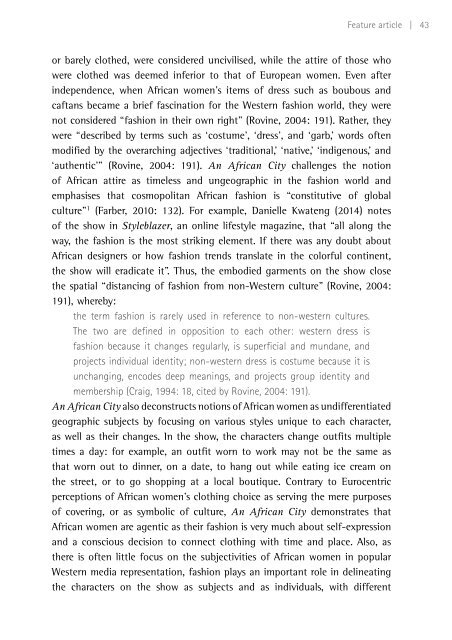The politics of fashion and beauty in Africa
fa21_proof_3
fa21_proof_3
You also want an ePaper? Increase the reach of your titles
YUMPU automatically turns print PDFs into web optimized ePapers that Google loves.
Feature article | 43<br />
or barely clothed, were considered uncivilised, while the attire <strong>of</strong> those who<br />
were clothed was deemed <strong>in</strong>ferior to that <strong>of</strong> European women. Even after<br />
<strong>in</strong>dependence, when <strong>Africa</strong>n women’s items <strong>of</strong> dress such as boubous <strong>and</strong><br />
caftans became a brief fasc<strong>in</strong>ation for the Western <strong>fashion</strong> world, they were<br />
not considered “<strong>fashion</strong> <strong>in</strong> their own right” (Rov<strong>in</strong>e, 2004: 191). Rather, they<br />
were “described by terms such as ‘costume’, ‘dress’, <strong>and</strong> ‘garb,’ words <strong>of</strong>ten<br />
modified by the overarch<strong>in</strong>g adjectives ‘traditional,’ ‘native,’ ‘<strong>in</strong>digenous,’ <strong>and</strong><br />
‘authentic’” (Rov<strong>in</strong>e, 2004: 191). An <strong>Africa</strong>n City challenges the notion<br />
<strong>of</strong> <strong>Africa</strong>n attire as timeless <strong>and</strong> ungeographic <strong>in</strong> the <strong>fashion</strong> world <strong>and</strong><br />
emphasises that cosmopolitan <strong>Africa</strong>n <strong>fashion</strong> is “constitutive <strong>of</strong> global<br />
culture” 1 (Farber, 2010: 132). For example, Danielle Kwateng (2014) notes<br />
<strong>of</strong> the show <strong>in</strong> Styleblazer, an onl<strong>in</strong>e lifestyle magaz<strong>in</strong>e, that “all along the<br />
way, the <strong>fashion</strong> is the most strik<strong>in</strong>g element. If there was any doubt about<br />
<strong>Africa</strong>n designers or how <strong>fashion</strong> trends translate <strong>in</strong> the colorful cont<strong>in</strong>ent,<br />
the show will eradicate it”. Thus, the embodied garments on the show close<br />
the spatial “distanc<strong>in</strong>g <strong>of</strong> <strong>fashion</strong> from non-Western culture” (Rov<strong>in</strong>e, 2004:<br />
191), whereby:<br />
the term <strong>fashion</strong> is rarely used <strong>in</strong> reference to non-western cultures.<br />
<strong>The</strong> two are def<strong>in</strong>ed <strong>in</strong> opposition to each other: western dress is<br />
<strong>fashion</strong> because it changes regularly, is superficial <strong>and</strong> mundane, <strong>and</strong><br />
projects <strong>in</strong>dividual identity; non-western dress is costume because it is<br />
unchang<strong>in</strong>g, encodes deep mean<strong>in</strong>gs, <strong>and</strong> projects group identity <strong>and</strong><br />
membership (Craig, 1994: 18, cited by Rov<strong>in</strong>e, 2004: 191).<br />
An <strong>Africa</strong>n City also deconstructs notions <strong>of</strong> <strong>Africa</strong>n women as undifferentiated<br />
geographic subjects by focus<strong>in</strong>g on various styles unique to each character,<br />
as well as their changes. In the show, the characters change outfits multiple<br />
times a day: for example, an outfit worn to work may not be the same as<br />
that worn out to d<strong>in</strong>ner, on a date, to hang out while eat<strong>in</strong>g ice cream on<br />
the street, or to go shopp<strong>in</strong>g at a local boutique. Contrary to Eurocentric<br />
perceptions <strong>of</strong> <strong>Africa</strong>n women’s cloth<strong>in</strong>g choice as serv<strong>in</strong>g the mere purposes<br />
<strong>of</strong> cover<strong>in</strong>g, or as symbolic <strong>of</strong> culture, An <strong>Africa</strong>n City demonstrates that<br />
<strong>Africa</strong>n women are agentic as their <strong>fashion</strong> is very much about self-expression<br />
<strong>and</strong> a conscious decision to connect cloth<strong>in</strong>g with time <strong>and</strong> place. Also, as<br />
there is <strong>of</strong>ten little focus on the subjectivities <strong>of</strong> <strong>Africa</strong>n women <strong>in</strong> popular<br />
Western media representation, <strong>fashion</strong> plays an important role <strong>in</strong> del<strong>in</strong>eat<strong>in</strong>g<br />
the characters on the show as subjects <strong>and</strong> as <strong>in</strong>dividuals, with different



